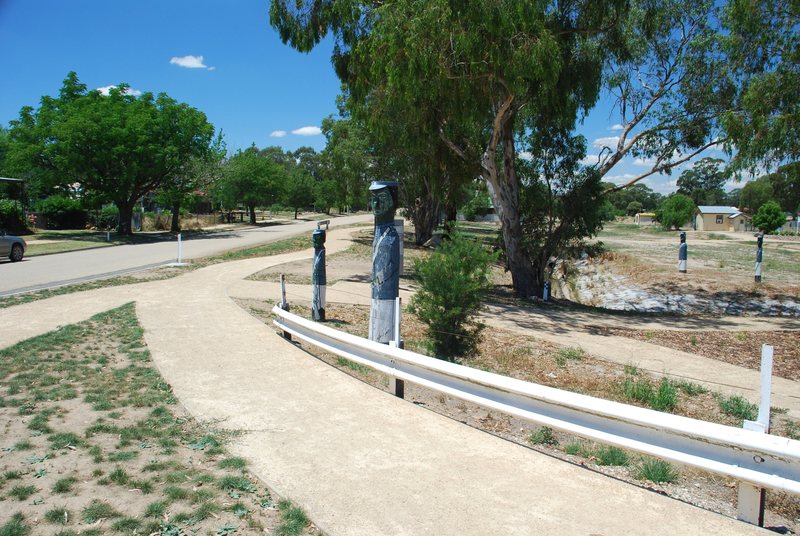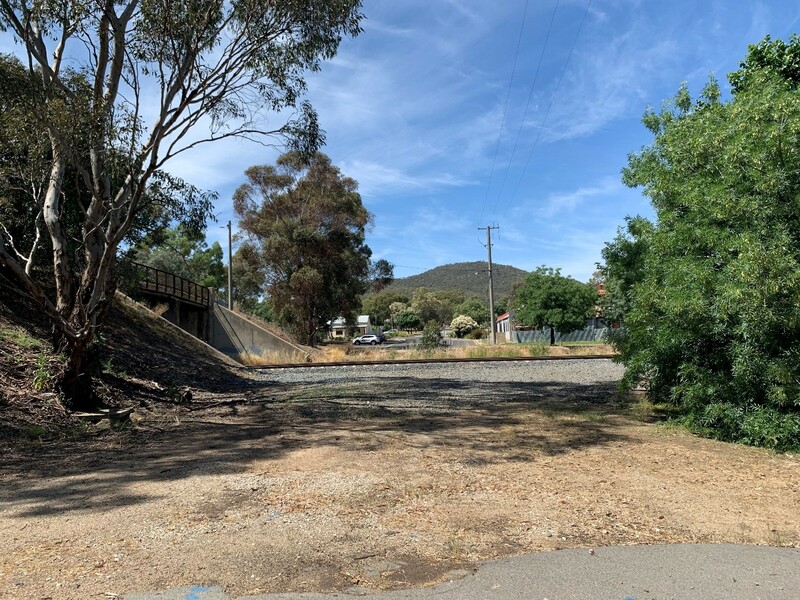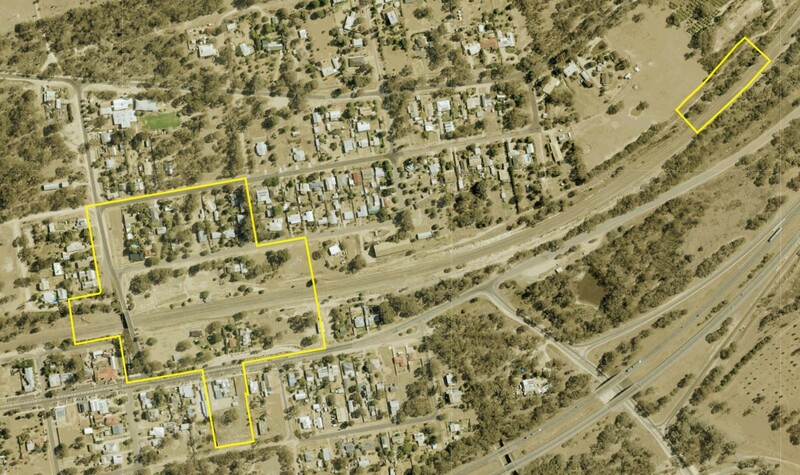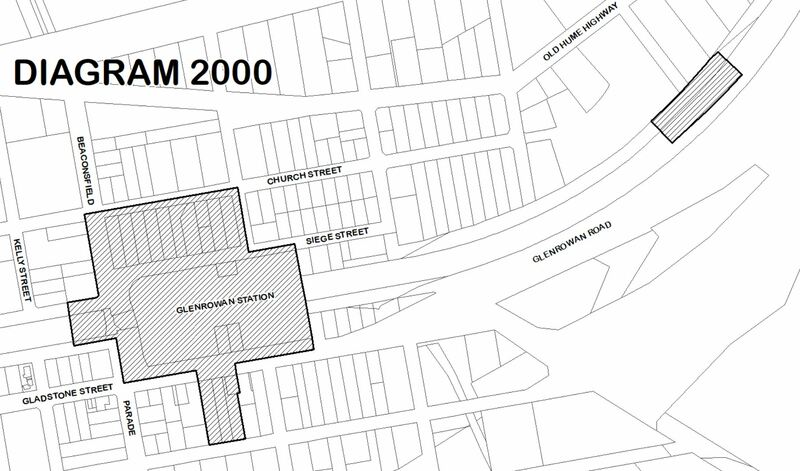GLENROWAN HERITAGE PRECINCT
SIEGE STREET GLENROWAN, WANGARATTA RURAL CITY
-
Add to tour
You must log in to do that.
-
Share
-
Shortlist place
You must log in to do that.
- Download report








Statement of Significance
What is significant?
The Glenrowan Heritage Precinct is an area in the town of Glenrowan associated with the notorious siege leading to the capture of the bushranger, Ned Kelly, and the deaths of his gang members Joe Byrne, Dan Kelly and Steve Hart in June 1880. Elements at the place include the topography and landscape within the vicinity of the Ann Jones’ Glenrowan Inn site, such as the remnant of the creek used for shelter by the police, various police positions, the original Glenrowan Railway Station platform and railway alignment, site of workers’ (plate-layers’) tents, the site of Ned Kelly’s fall and capture (the ‘Kelly Log’ site), the Stationmaster’ House site and the McDonnell's Hotel site. Many mature trees in the Precinct were extant at the time of the siege and one group, the 'Kelly copse' where Ned tethered his horse, is of particular note. The Precinct also includes the site of the attempted train derailment site east of town.How is it significant?
The Glenrowan Heritage Precinct is of historical and archaeological significance to the State of Victoria. It satisfies the following criterion for inclusion in the Victorian Heritage Register:Why is it significant?
The Glenrowan Heritage Precinct is historically significant as a key location in the history of bushranging in Victoria and as the place most intimately connected with the legend that surrounds Ned Kelly. The small town of Glenrowan is central to the history of the Kelly Gang. The members lived in the district and spent much time there among a population generally sympathetic to the outlaws. The Glenrowan Heritage Precinct marks the location of dramatic events that epitomise bushrangers' rebellion against authorities, namely the police. The Kelly Gang's plan for a final showdown with police by derailing a train was a feasible if reckless plan that suited itself to the topography of the town where the railway line between Benalla and Wangaratta makes a sweeping curve on a steep embankment. The subsequent siege, the police cordon, the use of suits of armour by the gang members, the capture of Ned and the burning of the Glenrowan Inn are firmly implanted in Australian folklore and are directly related to this physical place. [Criterion A]-
-
GLENROWAN HERITAGE PRECINCT - Permit Exemptions
General Exemptions:General exemptions apply to all places and objects included in the Victorian Heritage Register (VHR). General exemptions have been designed to allow everyday activities, maintenance and changes to your property, which don’t harm its cultural heritage significance, to proceed without the need to obtain approvals under the Heritage Act 2017.Places of worship: In some circumstances, you can alter a place of worship to accommodate religious practices without a permit, but you must notify the Executive Director of Heritage Victoria before you start the works or activities at least 20 business days before the works or activities are to commence.Subdivision/consolidation: Permit exemptions exist for some subdivisions and consolidations. If the subdivision or consolidation is in accordance with a planning permit granted under Part 4 of the Planning and Environment Act 1987 and the application for the planning permit was referred to the Executive Director of Heritage Victoria as a determining referral authority, a permit is not required.Specific exemptions may also apply to your registered place or object. If applicable, these are listed below. Specific exemptions are tailored to the conservation and management needs of an individual registered place or object and set out works and activities that are exempt from the requirements of a permit. Specific exemptions prevail if they conflict with general exemptions. Find out more about heritage permit exemptions here.Specific Exemptions:Introduction
The purpose of this information is to assist owners and other interested parties when considering or making decisions regarding works to a registered place. It is recommended that any proposed works be discussed with an officer of Heritage Victoria prior to making a permit application. Discussing proposed works will assist in answering questions the owner may have and aid any decisions regarding works to the place.
It is acknowledged that alterations and other works may be required to keep places and objects in good repair and adapt them for use into the future. However, under the Heritage Act 2017 a person must not knowingly, recklessly or negligently remove, relocate or demolish, damage or despoil, develop or alter or excavate all or any part of any part of a registered place without approval. It should be noted that the definition of ‘develop’ in the Act includes any works on, over or under the place.
If a person wishes to undertake works or activities in relation to a registered place or registered object, they must apply to the Executive Director for a permit. The purpose of a permit is to enable appropriate change to a place and to effectively manage adverse impacts on the cultural heritage significance of a place as a consequence of change. If an owner is uncertain whether a heritage permit is required, it is recommended that Heritage Victoria be contacted.
Permits are required for anything which alters the place or object, unless a permit exemption is granted. Permit exemptions usually cover routine maintenance and upkeep issues faced by owners as well as minor works or works to the elements of the place or object that are not significant. They may include appropriate works that are specified in a conservation management plan. Permit exemptions can be granted at the time of registration (under section 38 of the Act) or after registration (under section 92 of the Act). It should be noted that the addition of new buildings to the registered place, as well as alterations to the interior and exterior of existing buildings requires a permit, unless a specific permit exemption is granted.
Disrepair of registered place or registered object
Under section 152 of the Act, the owner of a registered place or registered object must not allow that place or object to fall into disrepair.
Failure to maintain registered place or registered object
Under section 153 of the Act, the owner of a registered place or registered object must not fail to maintain that place or object to the extent that its conservation is threatened.
Archaeology
Subject to relevant permit exemptions for this registered place, ground disturbance that may affect the historical archaeological remains (including artefacts) requires a permit.
Aboriginal cultural heritage
To establish whether this place is registered under the Aboriginal Heritage Act 2006 please contact First Peoples – State Relations. The Heritage Act 2017 and the Aboriginal Heritage Act 2006 are separate pieces of legislation. Please be aware that both Acts are required to be satisfied and satisfying the requirements of one Act may not satisfy the requirements of the other.
Human remains
If any suspected human remains are found during any works or activities, the works or activities must cease. The remains must be left in place and protected from harm or damage. Victoria Police and the State Coroner’s Office must be notified immediately.
Other approvals
Please be aware that approval from other authorities (such as local government) may be required to undertake works.
Notes
• Nothing in this determination prevents the Heritage Council from amending or rescinding all or any of the permit exemptions.
• Nothing in this determination exempts owners or their agents from the responsibility to seek relevant planning or building permits where applicable.
General Conditions
General Condition 1
All exempted alterations are to be planned and carried out in a manner which prevents damage to the fabric of the registered place or object.
General Condition 2
Should it become apparent during further inspection or the carrying out of works that original or previously hidden or inaccessible details of the place (including artefacts) are revealed which relate to the significance of the place, then the exemption covering such works shall cease and Heritage Victoria shall be notified as soon as possible.
General Condition 3
It is not the intention of this registration to prevent or preclude development within the Glenrowan Heritage Precinct, or to say that the existing fabric within the Precinct that postdates the siege has cultural heritage values that are significant in the context of this registration. The essence of the significance of this Precinct lies in its ability to interpret the events of 26-28 June 1880. Despite some development over the years, the intensity of use is low and the topography lends itself to interpretation.
General Condition 4
This place is likely to contain archaeological features, deposits and/or artefacts that relate to the historic siege and contributary events. Therefore, any subsurface works may be subject to a permit. This includes works to provide site services (gas, water, telephone, electricity etc), removal and construction of verandahs, decks, paving, driveways, internal floors and garden paths, or planting of new trees.
General Condition 5
The following documents should be consulted to ensure that the place is managed in a manner which respects its cultural heritage significance:
• Glenrowan Heritage Precinct, Conservation and Landscape Management Plan, prepared by Lovell Chen, dated 2018
• Glenrowan Heritage Precinct Landscape Technical Guidelines, prepared by John Patrick Landscape Architects, dated 2018
Permit Exemptions
The following permit exemptions are not considered to cause harm to the cultural heritage significance of the Glenrowan Heritage Precinct.
Buildings – private properties within the Precinct (excluding the Ann Jones Inn site)
Exterior (including private yards)
• Regular repairs and maintenance works, including repair and replacement of roofs, doors, windows and external wall cladding, and external re-painting of surfaces in the same colour. This permit exemption does not include construction of new buildings, structures or additions.
• Repair, replacement or removal of items such as external lighting, air conditioners, pipework, ducting, flues, wiring, antennae, aerials and flyscreens and making good.
• Maintenance and replacement of existing external electrical and fire services in the same location and of the same size.
• Works or activities, including emergency stabilisation, necessary to secure safety in an emergency where a structure or part of a structure has been irreparably damaged or destabilised and poses a safety risk to its users or the public. The Executive Director must be notified within seven days of the commencement of these works or activities.
• The processes of gardening including mowing, pruning, mulching, fertilising, removal of dead or diseased plants (excluding trees), installation, maintenance and replanting of garden beds, disease and weed control and maintenance to care for existing plants.
• Management and maintenance of trees including formative and remedial pruning, removal of deadwood and Emergency tree works to maintain public safety.
• Any works which require foundations and trenching are subject to further approval (either a permit or permit exemption), including works to provide site services, removal and construction of new buildings, structures, verandahs, decks, paving, driveways, internal floors and garden paths, or planting of new trees.
Interior
• All works within the internal footprint of the buildings which do not exceed the depth of existing foundations or expand internal floors.
Landscape and roads – all land not in private ownership within the Precinct
• The processes of mowing, pruning, mulching, fertilising, removal of dead or diseased plants (excluding trees), replanting of existing garden beds, disease and weed control and maintenance to care for existing plants and vegetation.
• Management and maintenance of trees including formative and remedial pruning, removal of deadwood and Emergency tree works to maintain public safety.
• Repair, removal or like for like replacement of external directional or interpretative signage provided the size, location and material remains the same.
• Regular repair and maintenance of standard park furniture and facilities, including park seating and shelters, picnic tables, drinking fountains and associated infrastructure, rubbish and recycling bins, and playground equipment and playground area surfaces. This exemption does not include replacement or installation of additional infrastructure.
• All works to maintain road safety and the existing road infrastructure. This includes: maintenance and repair of road pavement, speed humps, carparks, shoulder, median, pedestrian refuges/splitter islands, kerb and channels and similar supportive works. Maintenance, repair and replacement of safety-critical infrastructure including barriers of all types.
Transport Infrastructure within the Precinct (excluding the Stationmaster’s house site and the derailment marker)
• Removal, upgrade or replacement of railway tracks, sleepers and rail scraps.
• Removal, cleaning and replacement of ballast and tamping works.
• Minor re-levelling and re-alignment of the railway tracks that do not affect the existing platform or station building. This does not include the significant re-alignment of existing railway tracks.
• Clearing and cleaning of culverts and drainage areas along the railway track.
• Removal, upgrade and like-for-like replacement of power poles, powerlines and light poles.
• Painting and chemical corrosion treatment of signalling equipment.
• Removal, upgrade, and replacement of modern signalling or train monitoring equipment.
• Removal, upgrade, replacement or installation of auxiliary equipment such as cables, conduit and cable troughing.
• Removal, upgrade and replacement of signage associated with train operations and track maintenance such as survey pegs, kilometre posts, warning signs and speed signs.
• Removal, upgrade and replacement of emergency safety equipment such as ladders, steps and stairs.
• Removal, upgrade and replacement of communications and control systems such as signalling and emergency telephones and associated signage.
Safety and Security Works within the Precinct
• Works or activities, including emergency stabilisation, necessary to secure safety in an emergency where a structure or part of a structure has been irreparably damaged or destabilised and poses a safety risk to its users or the public. The Executive Director must be notified within seven days of the commencement of these works or activities.
• The erection of temporary security fencing, scaffolding, hoardings or surveillance systems to prevent unauthorised access or secure public safety, providing these works do not cause damage to significant fabric or views within the place and do not involve ground disturbance.
Temporary Events within the Precinct
The installation and/or erection of temporary elements associated with the hosting of community initiatives and special events up to seven days in duration which do not detrimentally impact the fabric or views of the heritage place or involve ground disturbance. At the conclusion of the event any affected areas of the place must be made good to match the condition of the place prior to installation.
Fire suppression activities
Fire suppression activities provided the works do not involve the removal or destruction of any significant above-ground features or sub-surface archaeological features, deposits and/or artefacts. Note: Fire management authorities should be aware of the location, extent and significance of historical and archaeological places/sites when developing fire suppression and firefighting strategies. The importance of places in the VHR must be considered when strategies for fire suppression and management are being developed.
-
-
-
-
-
GLENROWAN HERITAGE PRECINCT
 Victorian Heritage Inventory
Victorian Heritage Inventory -
Ned Kelly's Homestead Site
 National Trust
National Trust -
Glenrowan Post Office
 National Trust
National Trust
-
'ELAINE'
 Boroondara City
Boroondara City -
-oonah
 Yarra City
Yarra City -
..eld House
 Yarra City
Yarra City
-
-
Notes See all notes
Graeme Butler • 19/04/17
The SOS says `Significant fabric remaining from the event are the Stationmaster's house (relocated to 16 Siege Street from its original site) and the railway platform (the current station building is a recent remodelling). The station lamp room however is an early one with Redcliffe iron and may be part of the original scene?
Public contributions
Notes See all notes
Graeme Butler • 19/04/17
The SOS says `Significant fabric remaining from the event are the Stationmaster's house (relocated to 16 Siege Street from its original site) and the railway platform (the current station building is a recent remodelling). The station lamp room however is an early one with Redcliffe iron and may be part of the original scene?










